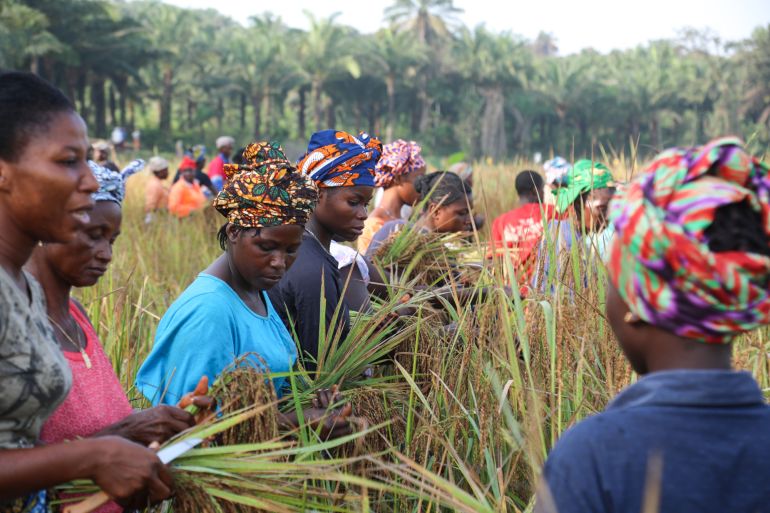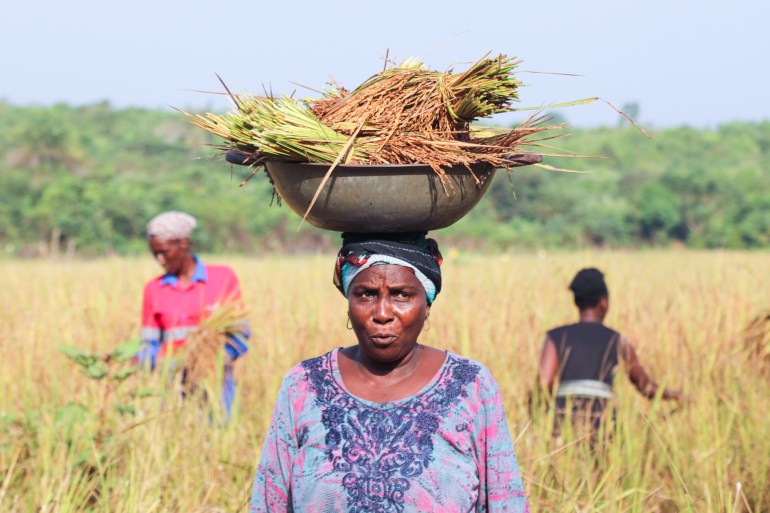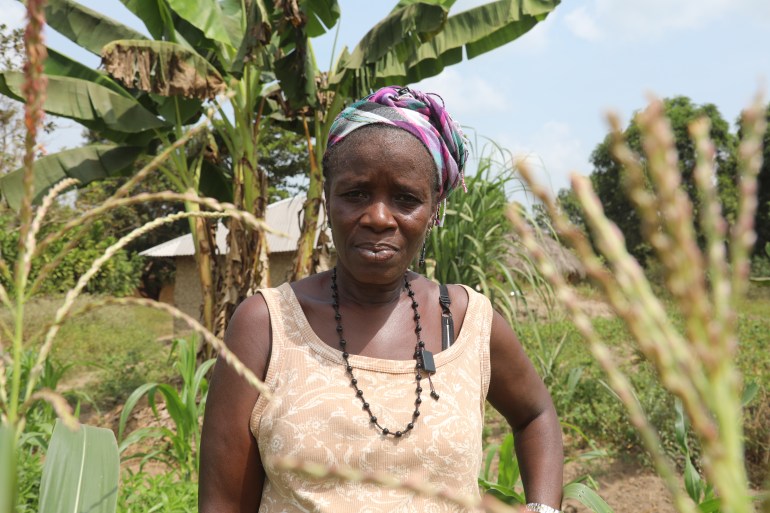In Sierra Leone’s swamps, female farmers make profits and peace
After a conflict with mining companies, some female farmers have adapted to work on an overlooked yet abundant ecosystem.

Matagelema, Sierra Leone – Not long after daybreak in Matagelema, a village in the south of Sierra Leone’s Moyamba District, a jubilant chorus rings out from a stretch of a once-neglected swamp surrounded by tropical forest.
“When we are ploughing, people are getting jealous,” dozens of women farmers sing gleefully, ankle-deep in mud in a sprawling paddy field.
Keep reading
list of 3 itemsCampaigners hail historic Sierra Leone move to end death penalty
The power of radio in Sierra Leone
Through their backbreaking work – carving out rice paddies from thickly-forested swamp land – peace and prosperity are gradually coming to the conflict-ridden corner of West Africa.
Mamie Achion, the group’s charismatic 45-year-old leader, gestures at orderly blocks of bunds and canals that form the new irrigation system.
“We cut the trees by hand. It was tough, there was pain,” she says. “But it was an opportunity for us and we have used it to better our lives.”
For many years, these women tilled the region’s uplands, mostly cultivating the root vegetable cassava.
But conflict regularly flared up between farmers and miners, who are extracting Moyamba’s rich deposits of rutile, a mineral used to make a bright white colour in ceramics and paint.
The struggle for resources led to violent tensions, with protests against mining including roadblocks by angry locals and even a local chief’s home being burned.
“We weren’t getting benefits from mining,” adds Achion. “The miners’ dredging created water pools in our fields, damaging the crop. They relieved us of our land.”
Born and raised in Matagelema, Achion – like many of the women – has also dealt with a lot of adversity besides conflict with mining companies.
Forced to drop out of school to support her farmer parents, Achion later lost her husband to Ebola, the deadly hemorrhagic fever that swept across the region in 2014.
“I wanted us [women] to come together,” she says. “Some don’t have fathers, mothers, brothers, husbands. Many of us are widows, because of Ebola and war.”
In 2020, about 150 women in Matagelema formed a women’s association and moved to work on inland valley swamps, an overlooked yet abundant ecosystem that has the potential for very high agricultural yields.

‘A stable foundation’
Sierra Leone relies heavily on agriculture, which employs more than 60 percent of the population (PDF) and accounts for almost half of the gross domestic product (GDP). Women represent about 70 percent of Sierra Leone’s agricultural workforce.
But farmers typically rely on shifting, upland agriculture, which results in low yields, food loss and environmental damage. Earlier, farmers in Matagelema would cut down trees without de-stumping them, burn the land, and “broadcast” the seeds in a scattershot method.
The flaws in that agricultural system have contributed to a shortage of food in Sierra Leone – worsened by inflation, COVID-19 pandemic and climate change – grow from 49 percent in 2010 to only 57 percent in 2020, according to Food Security and Nutrition Working Group data.
But the inland swamps are already proving much more effective.
Sierra Leone is naturally endowed with an estimated 260,000 hectares (642,500 acres) of inland valley swamps, which when irrigated can be harvested three times a year for rice as well as legumes, maize, peanut and okra. Crucially, given the growing amount of drought and crop failure brought on by climate change, the swamps have a year-round water supply.
According to the Ministry of Agriculture, the yield in Matagelema’s swamps is 2 metric tonnes of rice per hectare – more than triple the 0.6 metric tonnes average for uplands.
“It’s challenging but sustainable and they produce much more food,” says Al Haji Juana Brima, a front-line extension worker for the Ministry of Agriculture.
In the Matagelema association’s first meeting, the women agreed to contribute 5,000 leones ($0.44) each to register with the National Farmers’ Federation. They further invested 10,000 leones ($0.88) each to buy seeds and fertilisers to cultivate the 10 hectares (25 acres) of swamps that the group secured. All income is divided equally and the women have already built a community storage warehouse with the proceeds.
Mamie Feika, a 39-year-old divorcee with five children, says the harvests have allowed her to buy school books and uniforms.
“There’s a big improvement,” she says. “This can let us uplift ourselves. The labour is hard work, but it’s joyful being together. That’s the beauty of it.”
The World Food Programme (WFP) provided training for the group in using the swamps for agriculture.
Supported by the United Nations Peacebuilding Fund, the WFP is working with nearly 70 communities like those in Matagelema across six districts in Sierra Leone under the project. More than 4,000 farmers are now cultivating irrigation schemes across 890 hectares (2,200 acres) of these inland valley swamps, which to qualify must be only five minutes walk from the village and located on community-owned land.
The WFP provides cash and in-kind food as an incentive for completing various stages of the programme, including clearing bushes and building bunds and canals. The WFP is also providing training on reducing post-harvest food losses, improving governance structures and how to practise profitable group marketing.
“It’s gruelling work to prepare the terrain,” says William Hopkins, a WFP programme officer for agriculture activities in Sierra Leone.
“But once that is complete, the community really begins to benefit from the fruits of their labour. It can provide a stable foundation for the rest of their lives.”
Resolving conflicts
In theory, the model also has long-term sustainability as inland valley swamps have not been subject to conflict over natural resources, which in Sierra Leone dates back to the British colonial period and later in the country’s brutal civil war between 1991 and 2002.
To this day, land grabbing in other areas continues, particularly in the rural south, where powerful local chiefs often make deals with foreign companies without the consent of communities.
“The fact that many communities don’t benefit from mining and other industries is still a massive issue,” says Kieran Mitton, research director of the Conflict, Security & Development Research Group at King’s College London.
“There must be a way to resolve conflict in a way that is fair and impartial. But it’s precisely projects that address this problem, like in Matagelema, that can succeed.”

Osman Lahai, community relations and social development manager at Sierra Rutile, the largest company operating in the region, says the conflict has subsided in the surrounding villages.
“There’s always competition between farming and mining,” he says. “But now it’s trickled to a halt.”
Under Sierra Leonean law, authorities can allow mining to take place on any land on the condition that companies compensate the community. Last year, in addition to that basic compensation, Sierra Rutile provided $153,000 for infrastructure projects in Moyamba, such as installing water wells, building schools and distributing farming tools.
Yet some concerns remain. Rutile mining has flooded land across the region. By law, mines must be rehabilitated once they have been decommissioned.
And no project will be able to completely eradicate conflict, which has deeply-rooted origins. Consultation with communities over significant issues is seen as key to mitigating future disagreements, which will inevitably flare up from time to time. As part of the programme, the UNDP has created local grievance redress committees that provide an outlet for any frustrations to be voiced and then addressed in a formal manner.
That appears to be working well and miners are now seen as a potential market for women’s rice.
“We had a lot of problems with the miners before,” says Mohammad Ndoko, chief of Matagelema. “The women struggled. But this has brought jobs and prosperity. We are happy, we want more.”
In the future, Matagelema’s women could also provide rice and pulses to local schools as part of a “homegrown” scheme – currently in discussions – that would both secure demand for farmers and fight against child malnutrition.
Yet, plenty of hard work lies ahead. In parts of the swamps, fallow, sandy soil and reddish, iron-heavy water means farming can be challenging.
“Crops other than rice must be grown to improve fertility,” says WFP’s Hopkins.
While inland valley swamps are abundant, the realities of the geography of the region mean that some communities might not have any within close proximity.
And the agricultural schedule can be unforgiving. If the women are not sowing seeds, they must weed crops or carry out reparations. Once harvested, the rice must then be thrashed, dried, willowed and milled, before being bagged up for sale. “A delay in even a week could cause problems for the whole year,” he adds.
But for Achion and the other women farmers in Matagelema, their newfound autonomy and independence far outweigh any of the hard work, providing hope for the years ahead.
“I feel very happy,” says Achion, who bounds around the rice paddies, singing and chanting encouragement to her fellow farmers.
“The joy is so much more at the end of the day because we are working for ourselves.”